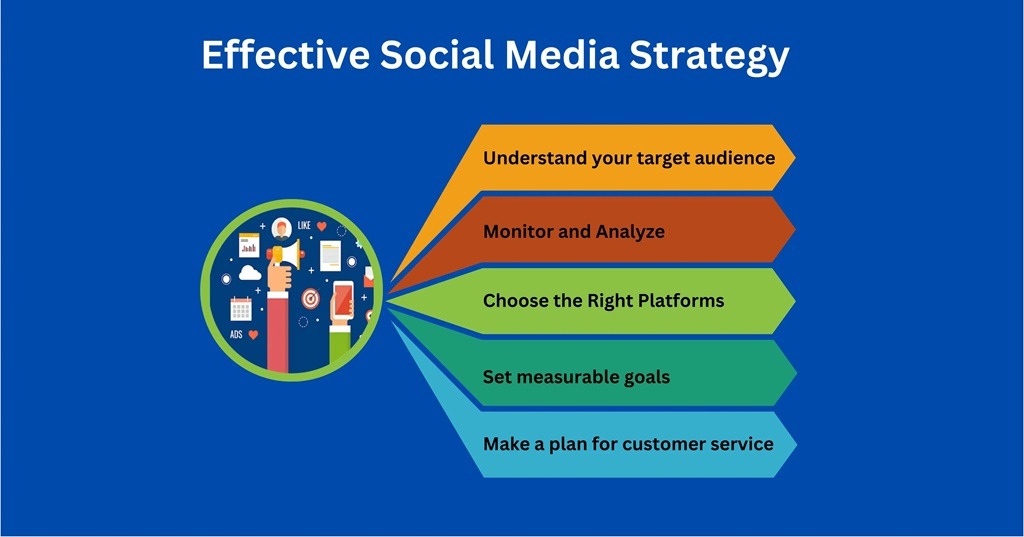Are you afraid that you just don’t know enough to get involved with social media? Or perhaps you’re wondering where to begin? Or Thinking, developing social media strategy ? A six-stage process can help you to develop a social media strategy so your company can start taking advantage of the opportunities social media presents.
The six stages are to
1) Determine your goal and target audience:
2) Define the time scale, budget, and measurement methods
3) Choose appropriate social media
4) Appoint communicators of the brand
5) Listen to the customers
6) Launch the social media strategy
The six stage process will lead you from the necessary groundwork through to the launch of your social media branding strategy and active participation in social media.

#1.Determine your goal and target audience
The social media network is vast and can quickly become overwhelming. Without a plan to focus your efforts, your social media interaction may not be as effective as they could be. So, in stage one you should start by aligning social media efforts with specific business goals and targeting the associated audience.
For example: An Investment bank wants to develop a social media branding strategy for its investment products. To make the most effective use of this strategy, the bank decides to align its social media efforts with the business goal of increasing sales in the 25 to 40 age demo graphic.
#2.Define the time scale, budget, and measurement methods
In stage two, time scale and measurement methods – both of which are impacted by budget – are defined. Because branding efforts are aligned with business goals, typically the more ambitious those goals are, the bigger the budget will be.
Time scale
How much time you have to execute your strategy – is influenced by the budget. Typically, the bigger the budget, the more time you’ll have. So the time you’ll have to achieve results using social media will be directly related to the time allowed for the goal to be achieved. Because your social media activities reinforce marketing efforts tied to business goals, expenditures need to stay within the budget allotted for those goals. While many social media sites are free, same that caters to specific audience or cause do charge a monthly membership fee.
However engaging in social media does have another cost of your organization will be concerned with – time spent. You’ll need to realistic when estimating time you can allocate to social media branding activities so they don’t negatively impact your regular duties.
America’s 100 biggest advertisers spent a record $109 billion on marketing
Business Thoughts: BUSINESS INSIDER “The 12 Companies That Spend The Most On Advertising”
To do this, choose metrics to track, collect data and decide when to take measurements to compare against the base line.
Choose Metrics:
First you need to choose which metrics to measure. This depends on your goal. For instance, if you’re interested in creating brand awareness, you’ll want to track that. If you’re interested in increasing traffic on your site, you may want to track the number of visits.
Typically, metrics that are tracked to measure success include page views per visitors, time spent per page, number of different visitors, number of interactions, perception or change in perception, awareness of your brand and responses to on line campaigns.
Collect data
Once you decide which metrics to track, you need to collect the data to establish a base line.This information reflects the current state of your social media efforts.
Compare
After the predetermined amount of time has passed, you can compare the data collected during that time to your baseline figures. This helps to satisfy the need to measure results and can be used to improve subsequent social media strategies.
Remember the bank working on its social media strategy? The team sets increasing sales leads by 20 % in three months as the goal for the bank’s new branding strategy. This goal aligns with one of the bank’s priority business goals – increasing sales in the 25 to 40 age demographic. And the strategy’s timescale coincides with the budget for achieving this strategic objective. The social media team then puts the appropriate tools in place to track how many online sales leads are generated during this time.
#3.Choose appropriate social media platform
Many social media platforms exists, and each one is best suited for a different use. Before launching your social media strategy, you need to consider what you’re using social media for and then determine which type of social media platform best support your objectives. This is a stage three of developing a strategy. Analyzing three criteria will help:
Types of social media platform,
Social media tools have different uses, including information sharing, recruiting, developing communities or advocating for consumers. If your primary goal is to share information, blogging is the best choice. Sites like LinkedIn will help in recruiting, while other tools similar to Twitter and blogging are good for developing communities, and social media sites like Facebook are great if you’re looking to promote consumer advocacy.
Types of information
When speed is a high priority, or if information changes quickly, tools like Twitter are appropriate. However, if speed isn’t that important or if information doesn’t change quickly, blogging may be suited to your purpose. Consider the type of information you’re sharing before choosing a tool. Does it need to be communicated quickly? Does new information need to become available quickly?
Demonstration of products
If you have a product or service to demonstrate, you’ll need a tool that supports audio-visual messages. For instance, blogging might not be as effective as tool like YouTube when you want to demonstrate products or service.
A final consideration when choosing a social media tool is whether you’re looking to engage other businesses or consumers. These two groups have different expectations and values when it comes to social media
For example, B2B or business to business, customers tend to value You Tube, Twitter, Linked In, Blogs, and Facebook in that order. On other hand, in B2C – business to consumer – relationships, the value placed on social media sites is typically highest with Facebook and move down through Twitter, You Tube, Blogs AND Linked In.
For Example, Starbucks is successful business that makes for a great case study on unique selling propositions. They went from a small coffee shop in Washington to one of the most recognized brands in America, and now with exceptional products and more than 17,000 retail stores in over 55 countries. Below is Starbucks organization wants to help consumers make informed about the “The Starbucks Reserve Roastery and Tasting Room in Seattle’s Capitol Hill is now open, through Facebook page
#4.Appoint communicators of the brand
In this stage you will determine who’ll speak for the brand and how. Some organizations appoint specific people or team, while others allow employees to get involved. When the opportunity to contribute is given to employees, your organization should establish clear rules of engagement to guide social media activity.
First, any one partaking in social media activities needs to comment within the framework of organizational security, confidentiality, and privacy policies. These policies are in place to protect employees, customers, your organization, and they need to be up held in social media setting. Next, you should comment only in your area of expertise. Focus on providing unique, individual perspectives and quality information that is meaningful and valuable to your audience.
All comments and interactions must be polite and respectful. Otherwise, you risk offending consumers, and then instead of promoting your brand. You’ll be spending your time trying to protect or repair your brand’s reputation
Responding to comments in a timely manner is important. It helps contribute to an image of being knowledgeable, and it also helps to quiet the rumors and speculation that can grow when responses take too long.
While a quick response is important, it’s equally important to take time to think before posting a comment. When you’re ready to post your comment, make sure it’s in best interest of organization, provide value, and respect the rules of engagement guiding social media in organization.
Best Thought: Neil Patel says, responding to comments is a responsibility that a blogger takes on when he or she chooses to publish an article.
#5.Listen to the customers
The fifth stage in developing social media strategy involves listening to customers before speaking.
“Listening” to online conversation is a great way to learn about what customers need and value. Review and consider what’s being communicated on social media sites and then use it to interact in meaning full ways that customers will find useful, and that will keep them connected to, and interested in, your brand.
#6.Launch the social media strategy
In sixth and final stage of the process that you use what you learned in stage five to launch your social media strategy. By putting customers at the center of your branding strategy, you’ll do a better job creating connections with them all. Maintaining these connections with your customers will help you stay in tune with what customers want .
In Conclusion Congratulations that you’ve read all the stages of social media strategy ! If you apply everything you’ve learned, you should have a great social media profile for your company/product, engaging with your audience, managing your social media company sites with terrific tools, and seeing the results of your social media activity. What else would you like to know about social media marketing strategy? Please ask your questions in the comments and share your own social media strategy tips, tools, and resources.

Delhi Courses Academy is a leading institute offering the best digital marketing course in Delhi, known for its practical training, affordable fees, and industry-focused curriculum. With 15+ certifications, 100% placement assistance, and hands-on projects, it prepares students for real-world challenges.

